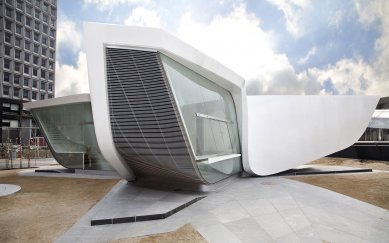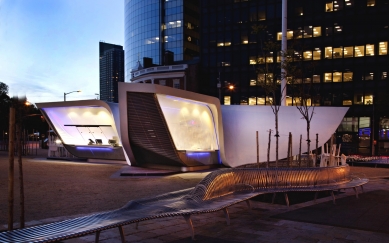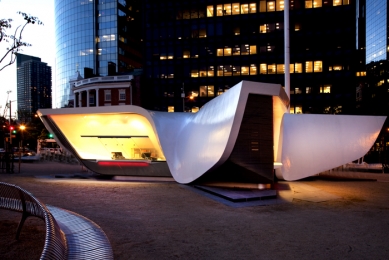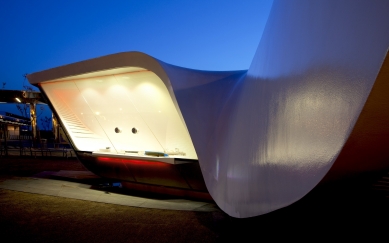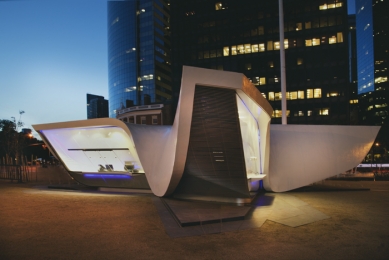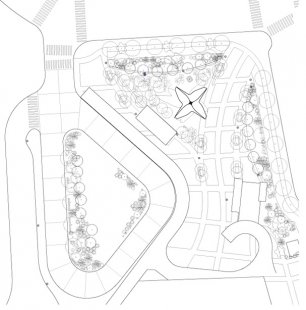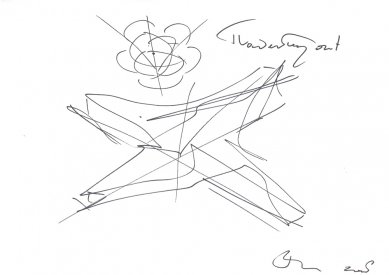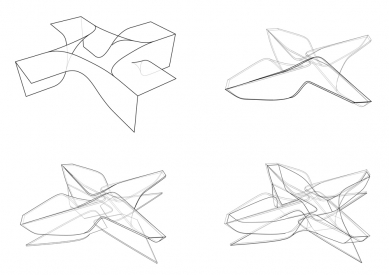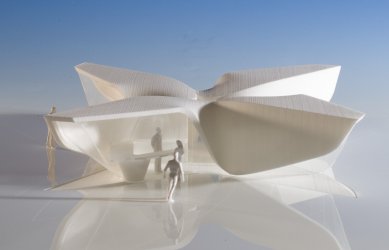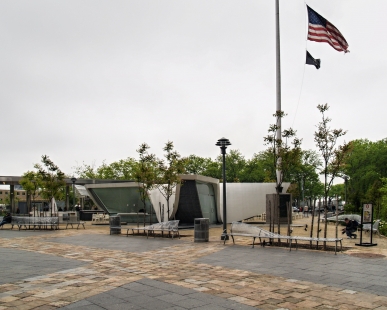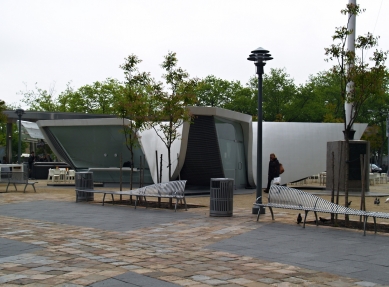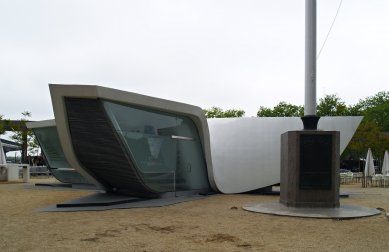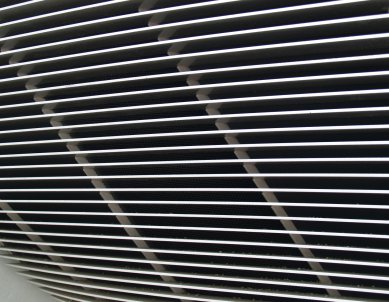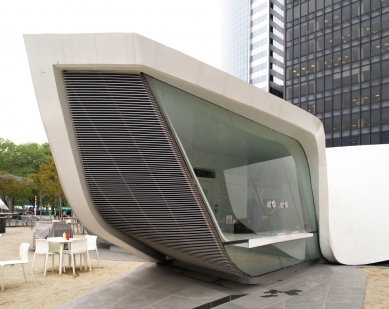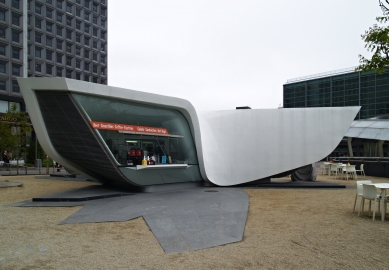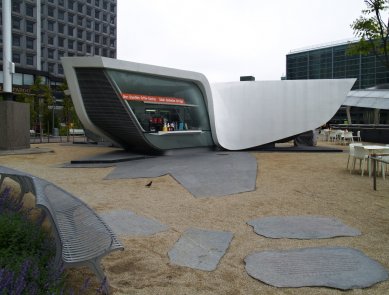
New Amsterdam Square & Pavilion

The Pavilion and New Amsterdam Square (plein in Dutch means square, open space) is located at Peter Minuit Plaza in Battery Park at the southern tip of Manhattan - the place where New York was born, then as New Amsterdam. The pavilion was created for the four-hundredth anniversary of the discovery of the bay by the Dutch East India Company and could be realized thanks to a generous donation of $2.3 million from the Kingdom of the Netherlands to New York. The Dutch are thus physically returning after 400 years to commemorate this event and affirm their friendship with New York.
The Dutch were the first inhabitants to settle at the southern tip of Manhattan after the bay was discovered by Henry Hudson in 1609, who, although he was English, sailed under the Dutch flag and founded New Netherland here. In 1625, New Amsterdam was established following the arrival of more settlers led by Dutch trader Peter Minuit. In 1626, he violated an agreement and purchased the island of Manna-hata from the Native Americans for $24 (which could be compared to today’s $1000). Following battles for control over the eastern coast of the New World, the English gained dominance in the area, and in 1667 New York was established (named after the then ruling Duke of York). The southern tip of Manhattan has always been a strategic point and has undergone various changes. It was a place of defense - a fort was established here, and artillery was stationed (hence the name Battery Park). In the 19th century, it was dominated by the shipping industry, which then moved to Brooklyn and New Jersey, giving way to offices and commerce of the financial center. To prevent complete financial exploitation of New York's most lucrative area, a non-profit organization called The Battery Conservancy was established, which fought for free space in Battery Park. New Amsterdam Plein & Pavilion is thus another continuation of the continuously changing face of Lower Manhattan.
According to architect Ben van Berkel, Peter Minuit Plaza is the place where history meets presence and future - today's transport hub, whose surroundings are constantly changing in the context of current events, is at the same time a place of this city that was discovered first.
The idea to build the pavilion originated from The Battery Conservancy in collaboration with the New York City Department of Parks and the Department of Transportation. They wanted to create a landmark of the 21st century that would also serve as a venue for smaller cultural events, whether planned or spontaneous, act as an easily identifiable meeting place for tourists and locals alike, mark the largest transport hub where all possible transportation in New York meets (subway, buses, taxis, boats, bicycles, and pedestrians), and of course, allow for some small food options (farmer's markets are held here where seasonal foods can be purchased). Over 150,000 travelers (both locals and tourists), commuting for work, leisure, or simply transferring, pass through here daily.
The pavilion's expressive and very sculptural shape can be interpreted in several ways - whether it resembles a typical Dutch windmill or a flower unfolding into its surroundings or alludes to its four wings celebrating the four-hundredth anniversary, there can be no doubt about its free expansion and soaring into the surroundings, dominated by glass skyscrapers. The solid center of the pavilion is utilized for permanent functions, unlike the wings, whose function can vary with the need for change in the surroundings. Currently, there is a small café, an information booth, and facilities for exhibitions and smaller installations. The pavilion divides the space into smaller and more private areas, creating quieter zones in the hectic and fast-paced place. As the architects themselves say, they wanted to create an outdoor living space.
Although the pavilion looks futuristic, its load-bearing structure is a traditional steel frame that forms the main framework and wooden ribs supporting layers of plywood, thermal insulation, and Corian. Corian was chosen for its thermoplastic properties, allowing for almost any shape to be achieved. This enabled the fluid form of the pavilion to materialize, where the roof seamlessly flows into the wall and back into the roof again. In manufacturing the shell, UN Studio collaborated with DuPont, which developed and produces Corian. Although the pavilion's shell is made of solid and opaque material, it opens generously to its surroundings with glass wings. The pavilion was constructed over nine months in Virginia, transported, and assembled from individual parts on site.
In the spirit of environmental and economic approaches, efforts are made to minimize operating costs through insulation, utilizing natural cross-ventilation, and LED lighting (initially, during the celebrations of the four-hundredth anniversary, nightly LED light shows were held, which were part of the architects' design to commemorate New Amsterdam's founder Peter Minuit, whose name in Dutch means midnight). The approach to material selection in creating a temporary structure, like the pavilion is meant to be, can be considered not entirely economic. However, Ben van Berkel sees the advantages of the pavilion, as a typological kind, precisely in its temporariness and in offering the possibility of testing new concepts and ideas (spatial, formal, and physical). The pavilion is not utilitarian in its limitations like buildings intended for long-term use and operation, thus allowing for testing new possibilities that can then be used in conventional construction.
During Hurricane Sandy, which swept through New York in late October 2012, a large part of Lower Manhattan was flooded with several meters of water. This had a tremendous impact on the entire Battery Park, which had recently undergone reconstruction and was covered with layers of mud and saltwater. Even a month later, volunteer efforts continued to bring the site back to its original state. The Amsterdam Pavilion did not escape the flood either and found itself underwater.
The Dutch were the first inhabitants to settle at the southern tip of Manhattan after the bay was discovered by Henry Hudson in 1609, who, although he was English, sailed under the Dutch flag and founded New Netherland here. In 1625, New Amsterdam was established following the arrival of more settlers led by Dutch trader Peter Minuit. In 1626, he violated an agreement and purchased the island of Manna-hata from the Native Americans for $24 (which could be compared to today’s $1000). Following battles for control over the eastern coast of the New World, the English gained dominance in the area, and in 1667 New York was established (named after the then ruling Duke of York). The southern tip of Manhattan has always been a strategic point and has undergone various changes. It was a place of defense - a fort was established here, and artillery was stationed (hence the name Battery Park). In the 19th century, it was dominated by the shipping industry, which then moved to Brooklyn and New Jersey, giving way to offices and commerce of the financial center. To prevent complete financial exploitation of New York's most lucrative area, a non-profit organization called The Battery Conservancy was established, which fought for free space in Battery Park. New Amsterdam Plein & Pavilion is thus another continuation of the continuously changing face of Lower Manhattan.
According to architect Ben van Berkel, Peter Minuit Plaza is the place where history meets presence and future - today's transport hub, whose surroundings are constantly changing in the context of current events, is at the same time a place of this city that was discovered first.
The idea to build the pavilion originated from The Battery Conservancy in collaboration with the New York City Department of Parks and the Department of Transportation. They wanted to create a landmark of the 21st century that would also serve as a venue for smaller cultural events, whether planned or spontaneous, act as an easily identifiable meeting place for tourists and locals alike, mark the largest transport hub where all possible transportation in New York meets (subway, buses, taxis, boats, bicycles, and pedestrians), and of course, allow for some small food options (farmer's markets are held here where seasonal foods can be purchased). Over 150,000 travelers (both locals and tourists), commuting for work, leisure, or simply transferring, pass through here daily.
The pavilion's expressive and very sculptural shape can be interpreted in several ways - whether it resembles a typical Dutch windmill or a flower unfolding into its surroundings or alludes to its four wings celebrating the four-hundredth anniversary, there can be no doubt about its free expansion and soaring into the surroundings, dominated by glass skyscrapers. The solid center of the pavilion is utilized for permanent functions, unlike the wings, whose function can vary with the need for change in the surroundings. Currently, there is a small café, an information booth, and facilities for exhibitions and smaller installations. The pavilion divides the space into smaller and more private areas, creating quieter zones in the hectic and fast-paced place. As the architects themselves say, they wanted to create an outdoor living space.
Although the pavilion looks futuristic, its load-bearing structure is a traditional steel frame that forms the main framework and wooden ribs supporting layers of plywood, thermal insulation, and Corian. Corian was chosen for its thermoplastic properties, allowing for almost any shape to be achieved. This enabled the fluid form of the pavilion to materialize, where the roof seamlessly flows into the wall and back into the roof again. In manufacturing the shell, UN Studio collaborated with DuPont, which developed and produces Corian. Although the pavilion's shell is made of solid and opaque material, it opens generously to its surroundings with glass wings. The pavilion was constructed over nine months in Virginia, transported, and assembled from individual parts on site.
In the spirit of environmental and economic approaches, efforts are made to minimize operating costs through insulation, utilizing natural cross-ventilation, and LED lighting (initially, during the celebrations of the four-hundredth anniversary, nightly LED light shows were held, which were part of the architects' design to commemorate New Amsterdam's founder Peter Minuit, whose name in Dutch means midnight). The approach to material selection in creating a temporary structure, like the pavilion is meant to be, can be considered not entirely economic. However, Ben van Berkel sees the advantages of the pavilion, as a typological kind, precisely in its temporariness and in offering the possibility of testing new concepts and ideas (spatial, formal, and physical). The pavilion is not utilitarian in its limitations like buildings intended for long-term use and operation, thus allowing for testing new possibilities that can then be used in conventional construction.
During Hurricane Sandy, which swept through New York in late October 2012, a large part of Lower Manhattan was flooded with several meters of water. This had a tremendous impact on the entire Battery Park, which had recently undergone reconstruction and was covered with layers of mud and saltwater. Even a month later, volunteer efforts continued to bring the site back to its original state. The Amsterdam Pavilion did not escape the flood either and found itself underwater.
The English translation is powered by AI tool. Switch to Czech to view the original text source.
0 comments
add comment


